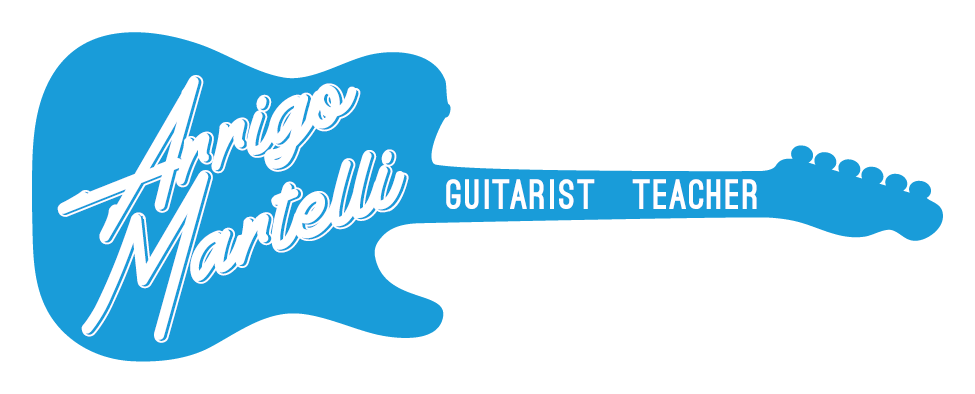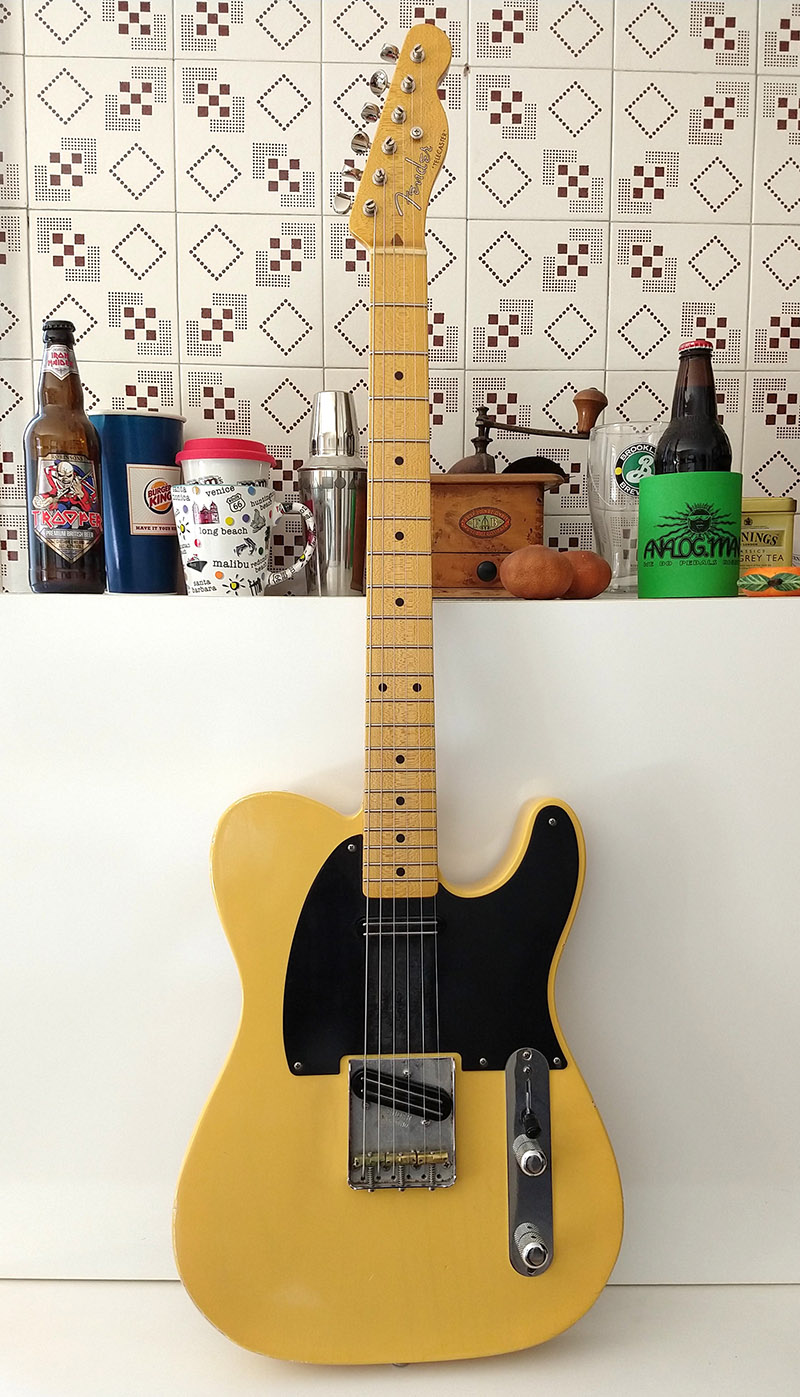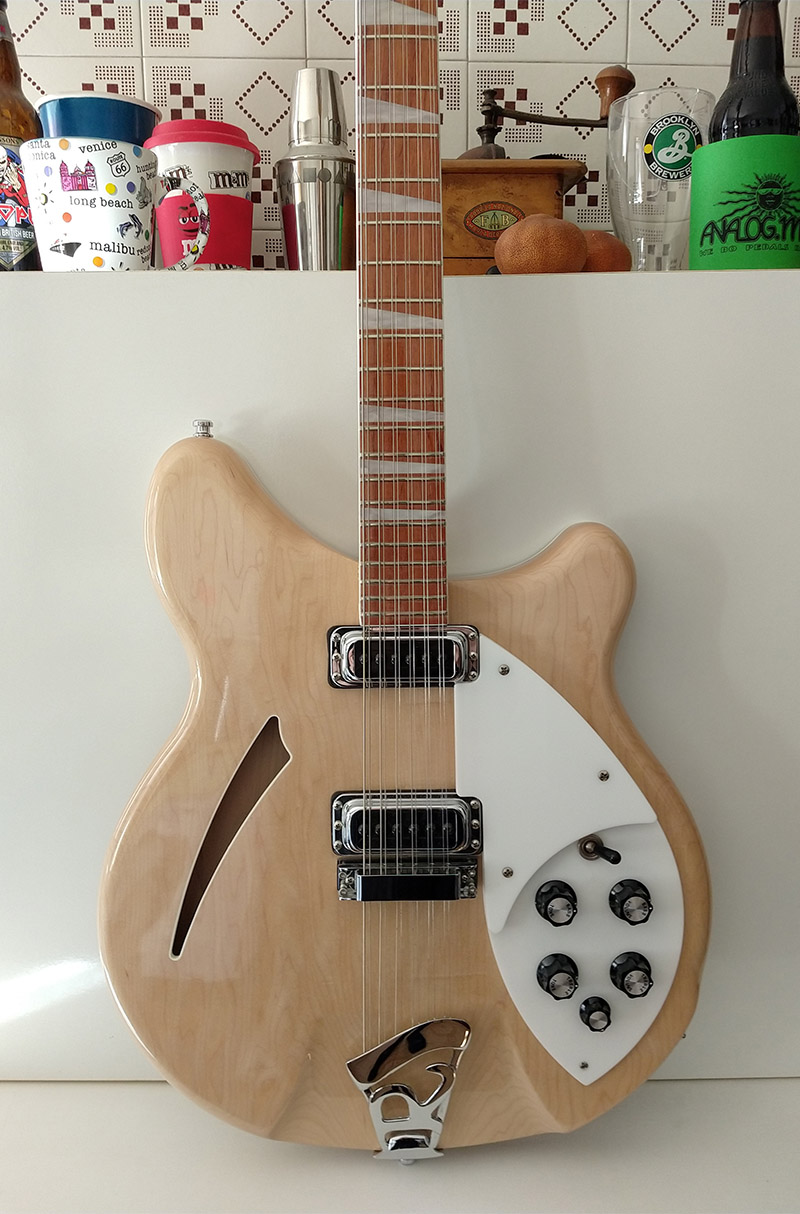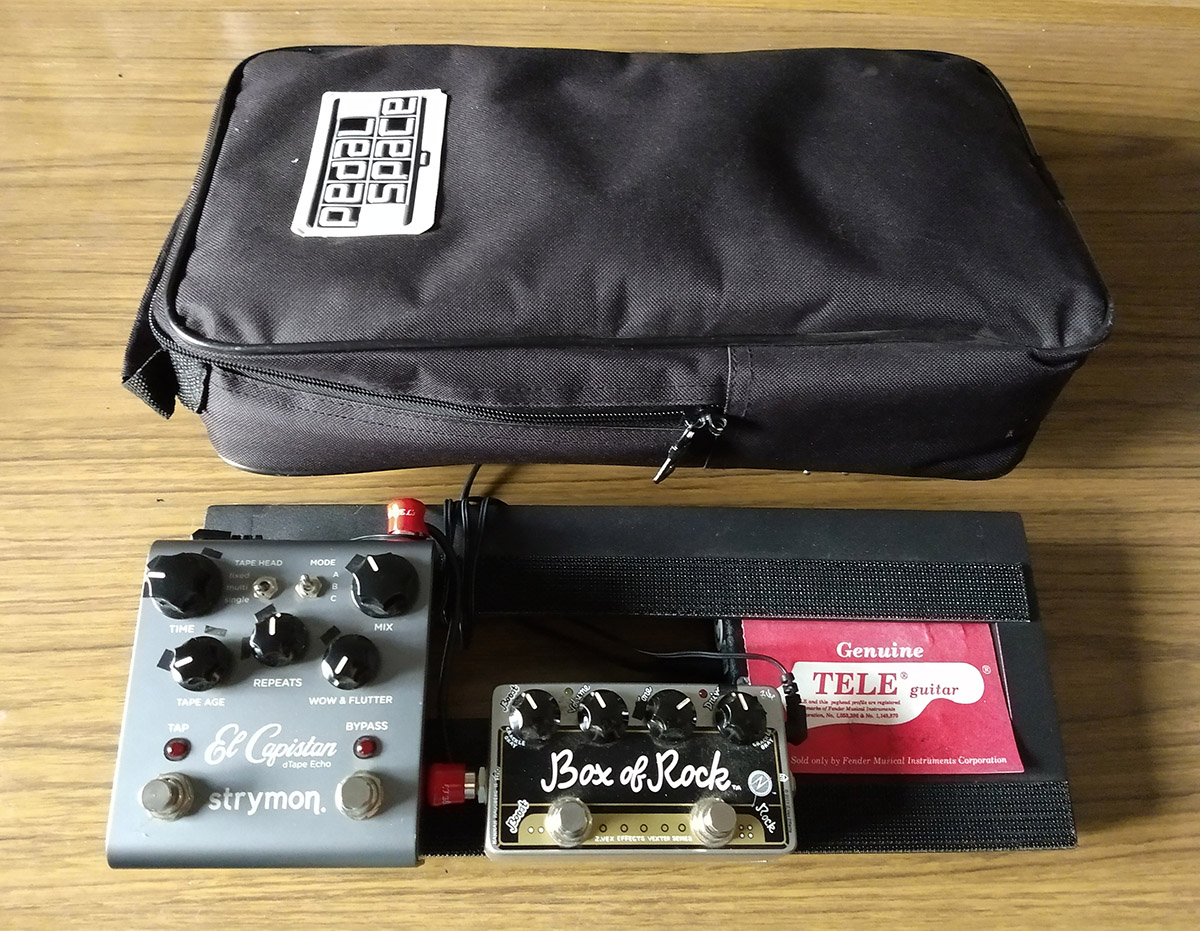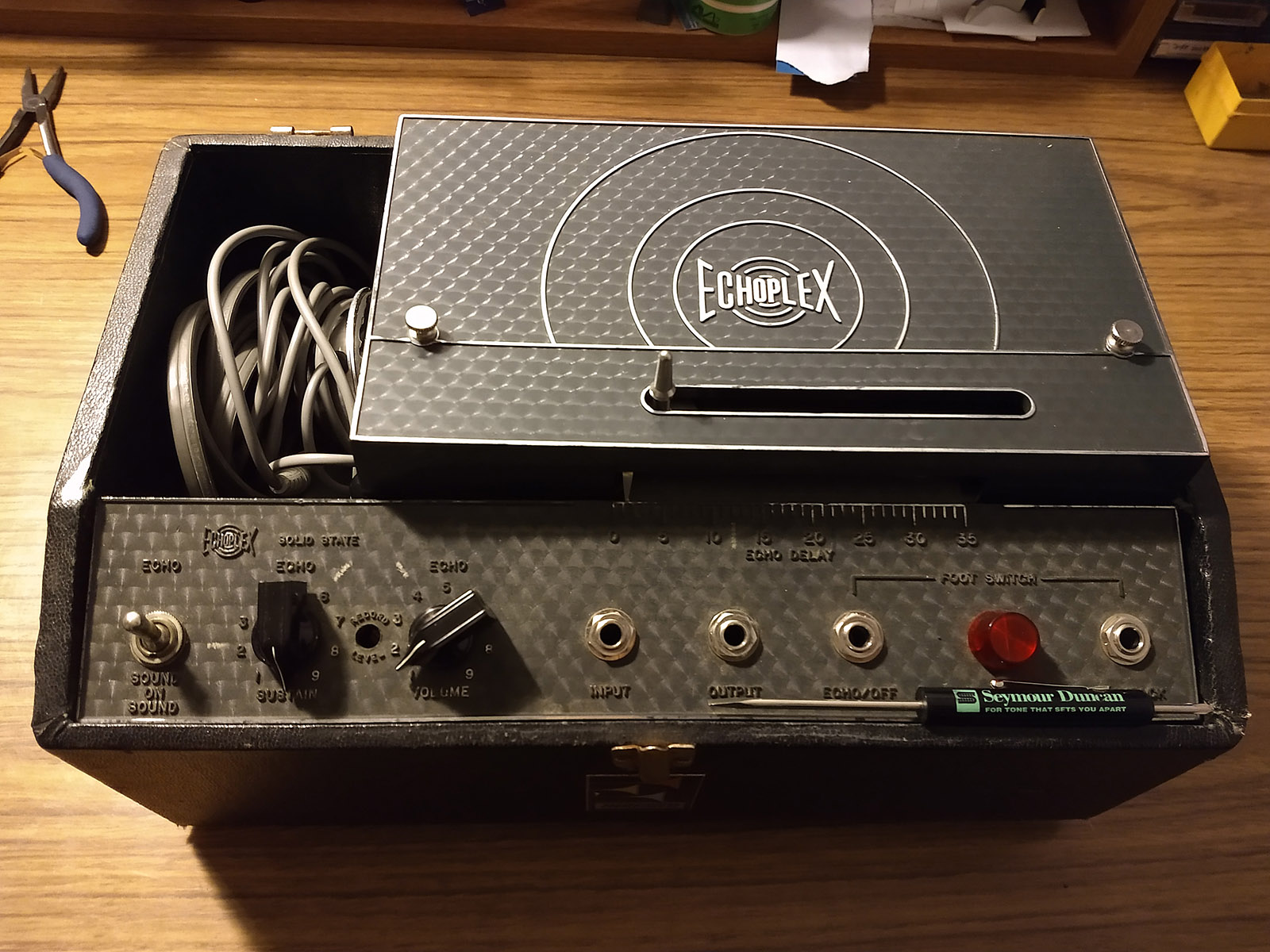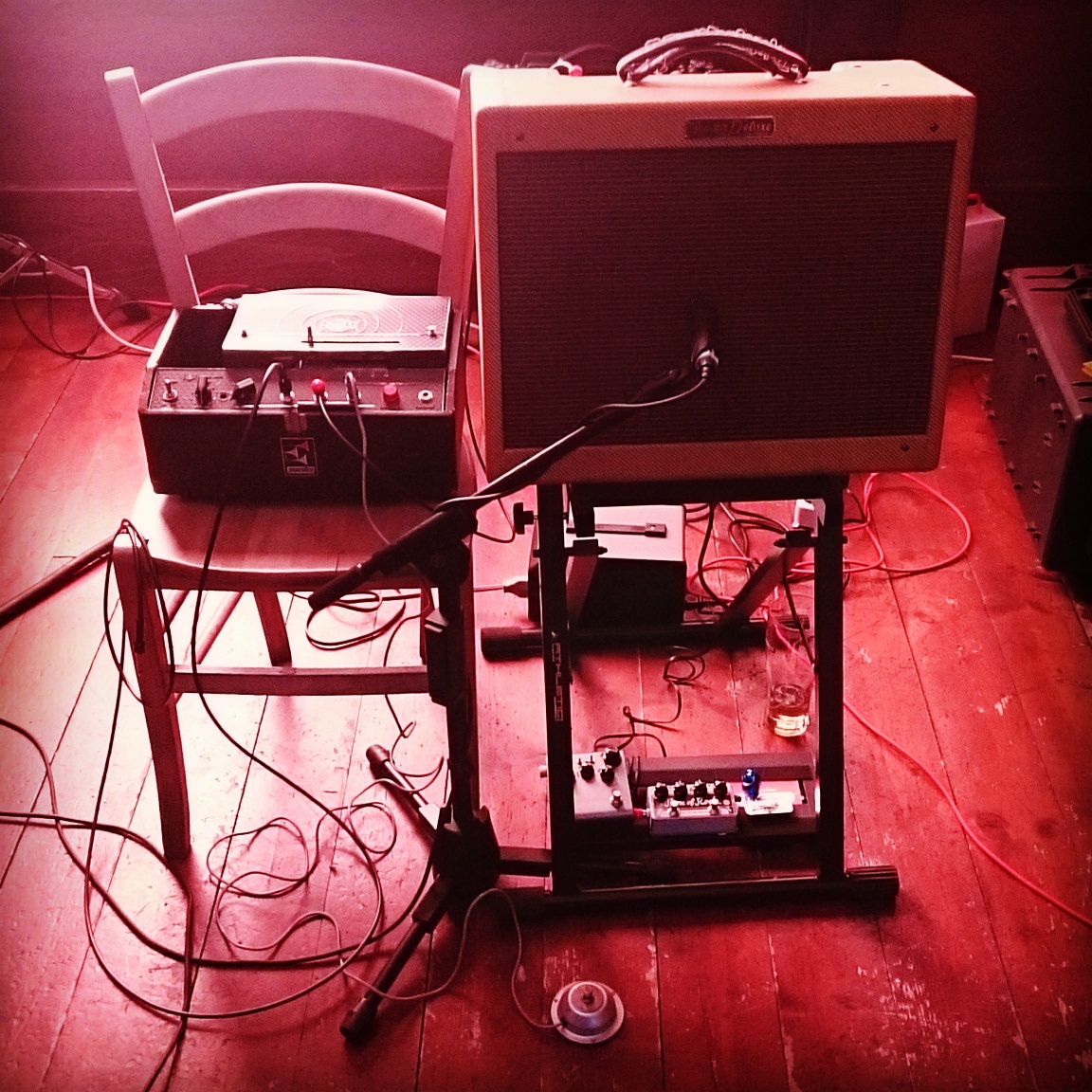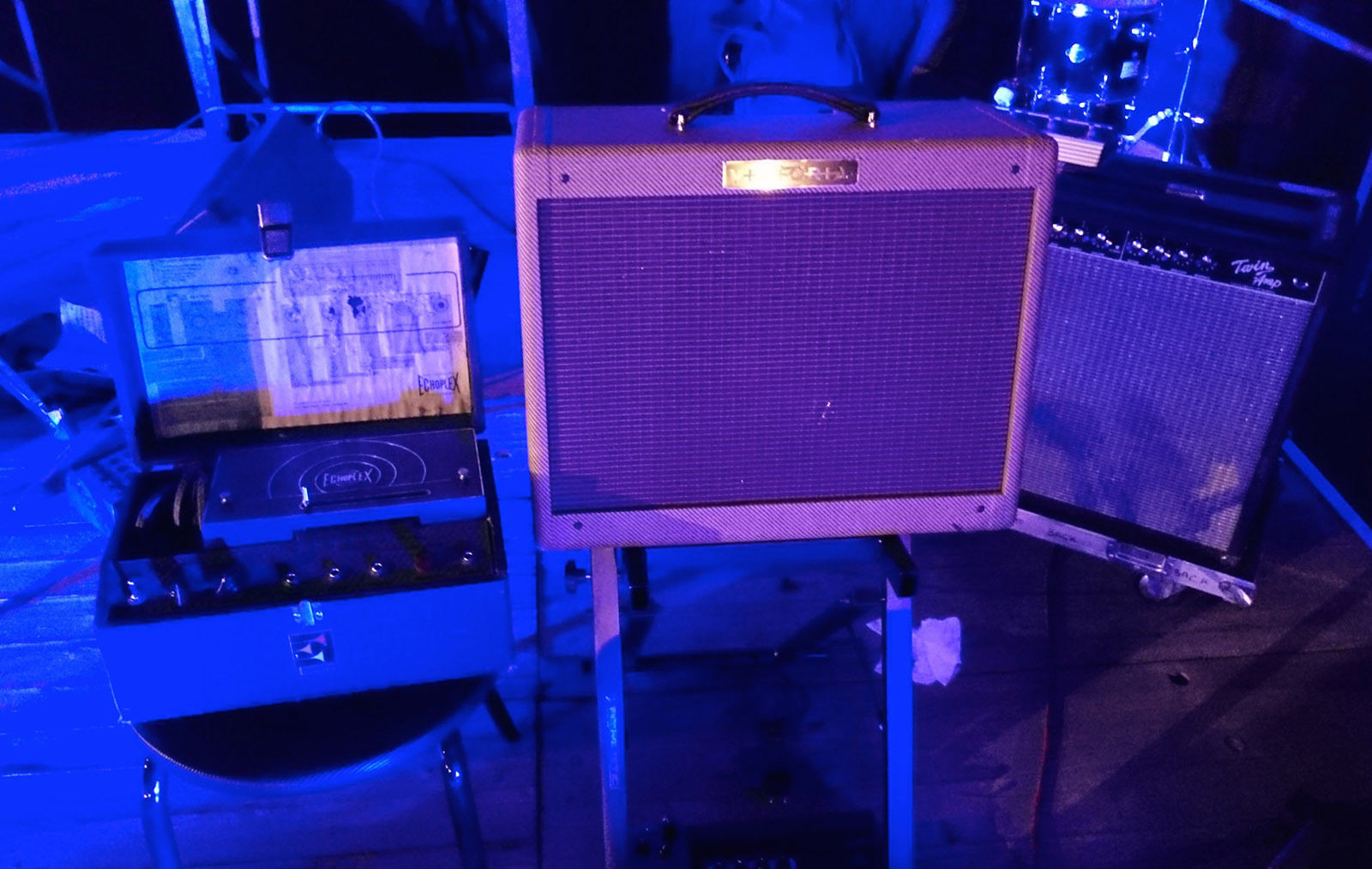Here is some of the gear I use.
As far as tone is concerned, I would say I’m pretty much a traditionalist;
for the type of music I play I find that the classic combination of a Telecaster guitar into a cranked, Fender style amp, is still hard to beat.
I got this Fender Road Worn Telecaster in 2015. I kept it stock for a while but soon felt the need to hot rod it, as I do with most of my guitars. The guitar had a very nice, resonant, lightweight alder body, finished in nitrocellulose lacquer. I didn’t particularly bond with the stock soft-V neck profile tough, as I tend to prefer U or D profiles (which allows me to position my left hand thumb on the back of the neck). I got rid of the stock neck and ordered a Musikraft Blackguard Series 1953 neck. Other than that, I installed Joe Barden pickups (my favorite pickups for the Telecaster) and a set of Callaham brass compensated saddles (among the best on the market).
As far as the electronics are concerned, I installed a simple treble bleed circuit on the volume pot and modded the tone potentiometer to no-load. A surprisingly cheap and effective modification, a no-load tone pot effectively removes itself from the signal chain when the tone is set to 10; when the knob is below 10, it does its job just as intended). This gives me the extra option of a brighter and clearer tone at a turn of a knob, which I find especially useful when playing live.
This is my favorite Telecaster: it feels and sounds great and is remarkably versatile, especially for a 70-year old design! While this instrument allows me to pull off most of what I need to do on one guitar, I especially enjoy this particular guitar for playing rockabilly, swing and country music.
SPECS
- Body: Alder
- Neck: One-piece quarter sawn maple;
gloss, vintage tint, nitro finish - Profile: 53 D — .90-.97
- Radius: 9.5”
- Frets: 21, 6105 Stainless Steel
- Bridge: stock Fender ashtray unit
- Pickups: early 2000s, original production
Joe Barden bridge – current production
JBE neck - Switching: CRL 3 Way
- Finish: Blonde
- Inlays: Black dots
This is the second Telecaster that I ever bought (in 2006). Surely a fine looking guitar, I loved the natural finish on the ash body and thought this would be the right guitar for a dual humbucker conversion. The idea behind this second Telecaster was to get as close as possible to the Telecaster that Seymour Duncan customized for Jeff Beck in the early 1970s, which was featured in the song ‘Cause We Ended As Lovers (from the Blow By Blow album), known as the Tele-Gib.
While I didn’t particularly like Jeff Beck’s tone on that album (although he’s one of my favorite guitarist and admire his style a lot!) I thought the idea of a humbucker-equipped Telecaster was great… and I simply couldn’t afford a Les Paul at that time! The guitar now features a Warmoth neck, with a super nice ’59 profile and their compound radius fretboard (whereas a straight radius neck uses a single radius down the entire length of the fretboard, a compound fretboard starts with a smaller radius in the lower frets, and transitions gradually to a flatter radius in the higher frets). I feel this innovation certainly improves playability to a certain extent, allowing greater speed and cleaner string bending as the player moves up the neck, but it does affect the overall playing experience, which feels a lot more modern, especially when compared to your typical Telecaster.
A versatile all-rounder, I love this guitar for classic rock distorted tones, but it’s equally at home when a warm, clean sound is needed, such as for playing traditional jazz or swing.
SPECS
- Body: Ash
- Neck: One-piece maple – gloss finish
- Profile: ’59 C — .86-.96
- Radius: Compound 10”-16”
- Frets: 22, 6105 Stainless Steel
- Bridge: Joe Barden half-plate “top loader”
- Pickups: Seymour Duncan Alnico 5 Seth Lover neck – stock (Alnico 2) Seth Lover bridge—the best P.A.F. style pickups around: these pickups almost have a bright, single coil quality to the sound which I’ve never found in other humbuckers. They are unpotted like the originals and wound on the same Leesona winding machine responsible for the humbuckers found on ’50s and ’60s Gibson guitars.
- Switching: CRL 3 Way
- Finish: Natural
- Inlays: Black dots
As far as I remember, I had dreamed of owning a Rickenbacker 12 string since I watched the movie Forrest Gump and heard the song Turn Turn Turn by the Byrds from the movie soundtrack (the remarkable scene where Forrest watches his girl Jenny waving him goodbye from the back window of the bus). Of course I didn’t know who The Byrds were then, nor that they played Rickenbacker guitars. But the sound I heard, that bright, shimmering guitar sound caught my attention in a way that I had never experienced before. During my teenage years Rickenbackers quickly became the guitars of my dreams (and the Byrds one of my favorite bands too). But for a 13-year old boy who was studying classical guitar at the Music Academy and was struggling with school and growing up, that dream guitar eventually took a back seat to more pertinent issues… but I always kept a place in my heart for it. Anyhow… 20 some years later I decided it was the right time and I finally purchased a mapleglo, Rickenbacker 360/12 string, just like the guitar Roger McGuinn, the leader of the Byrds, played on the band’s greatest songs.
What is it like to play a Ric? Well, it’s not an easy guitar, it is quite quirky and unlike all the other guitars I’ve played: frets are too low, the neck is too narrow, strings too close to each other… but it makes such a wonderful sound!
The guitar is 100% stock for now, but I’m probably going to cut a new nut for it and try to come up with a slightly wider spacing in order to improve the playability; furthermore, I know I will get a set of toaster single coil pickups, which have a different design than the hi-gains
currently installed by Rickenbacker (the higain pickup was introduced by Ric in the late 60s as a replacement, it’s a ceramic pickup which sounds fine, but it misses the chime and jangle of the old style toaster).
While I don’t really use the acoustic guitar for my live concerts that often, I certainly use this J45 a lot for my teaching. It is a nice guitar, sturdy and reliable, with a warm, woody sound that I find very pleasing. I’m a big fan of this old design…. plus Buddy Holly played one of these!
SPECS
- Top material: Sitka Spruce
- Back and sides: Mahogany
- Finish: Nitrocellulose
- Neck: Mahogany
- Profile: Slim taper
- Scale Lenght: 24.75”
- Fingerboard material: Rosewood
- Radius: 12”
- Frets: 20, Nickel-Silver
- Inlays: Mother-of-pearl dots
I’m happy to say that I reached a point in my life where I like to have as few things as possible between my guitar and the amplifier.
I’ve certainly had my dose of GAS, and tried a substantial amount of pedals and stompboxes in my heyday, but, thankfully, for the style of music that I mostly play nowadays, I can get the tone I like out of a guitar, a tube amp turned up loud and a bit of slapback echo.
Honestly, no pedal sounds like a real amp cranked, at least not to my ears. And nothing can beat a real tape echo. However, since not every venue where I perform lets me cut loose and crank my amps as loud as I please, I do have a small, portable board: I’m a fan of Strymon for time and Zvex for dirt.
Current main board signal goes:
Zvex “Box Of Rock”
Strymon “El Capistan”
…yes, not even a tuner!
This effect deserves a chapter for itself. I always wanted an Echoplex. All my guitar heroes had one, Joe Walsh (please do yourself a favor and listen to the song The Bomber, by The James Gang to hear the ‘Plex in all its glory), Jimmy Page, Tommy Bolin, Eddie Van Halen, Danny Gatton…
The Echoplex is a tape delay unit, i.e. it uses analog recording tape to achieve the effect. Nothing sounds like an Echoplex.
Yes, you need to learn some basic maintenance in order to have it perform its work properly, but I’m happy to say that, despite all the horror stories I’d read online, once I had the unit serviced properly, it has always behaved reliably and never let me down.
I’d like to stress that this is not a toy or a piece of 1970’s memorabilia, this is my main echo machine and I use it on a regular basis: 90% of the time I set it for a quick slapback echo, but the Echoplex is capable of a lot more.
I am currently using a Victoria 5112 for most of my gigs. It is a single ended, 5 watt tube amp based on the 1950s Fender 5F1 “Champ” circuit. Believe it or not, this little guy can hold up with my 4-piece band no problem, unless you need a totally clean sound. The amp has pretty robust
output transformer and I also swapped out the stock speaker for a Celestion G12H… american tone with a little british twist. Best feature of the
amp: it has one single knob, VOLUME.
While I don’t currently own one, my all time favorite amp is the Fender 5E3 tweed Deluxe. I’ve used on for a number of years, cranking it at jazz, swing or rockabilly gigs. It’s not considerably louder than the Victoria Champ, but it does have a more complex, refined tone to my ears. It can go from warm and snappy to a gritty, compressed tone quite nicely. The mighty Tweed Deluxe always delivers.
For many years I’ve also used a tweed Bassman, which I still own but rarely use. It’s a great pedal platform but it’s definitely designed to be tight
and clean, whereas I prefer compression and touch sensitivity… Moreover, I wouldn’t call it “ear friendly” inlays terms of volume either!
